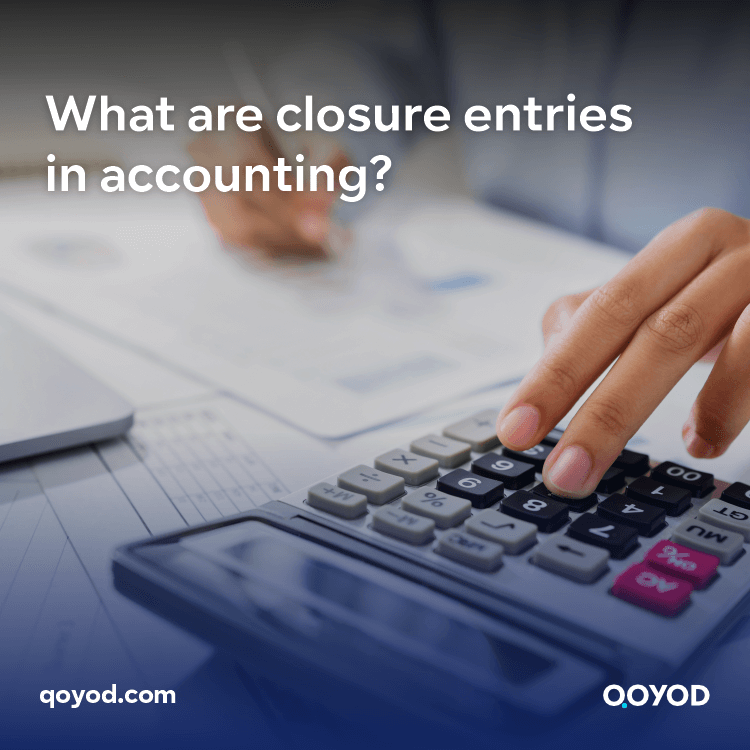Imagine if there was a magical way to make the process of closing the fiscal year easy and simple and get rid of the difficulties and complications that accompany it. Did you know that there is a tool that turns this cumbersome task into easy and enjoyable steps? Let me give you the secret that will change the way you deal with the closing of the financial period in the world of accounting:
Closure Entries is the magic secret that simplifies the process of closing a fiscal year, and it is like magic colors that appear in your hands, transforming the complex into easy and the unknown into known. When you rely on a strong and specialized accounting program, such as Qoyod, you will feel as if you are working with a professional magician who provides you with a set of simple options to prepare that type of entry.
What is the meaning of closure entries?
It is an essential step at the end of the financial year, as it aims to correct any operations or transactions that were not recorded during the fiscal year in order to ensure the accuracy and correctness of accounting statements and achieve compliance with recognized accounting standards.
Note
Companies must adhere to accounting restrictions related to closing and implement appropriate procedures to ensure accuracy and reliability in accounting records. It is worth noting that companies are likely to face challenges in this process, such as time pressure and the complexities of financial transactions, but through the presence of strong procedures and a specialized accounting program, such as Qoyod, these challenges can be overcome.
Points to consider in the closing process
Closure Entries: In accounting, there is a set of procedures and recordings that must be made at the end of the fiscal year, and among the most important points that must be taken into account in the closing entry are the following:
Inventory Valuation
The company is required to evaluate the value of the remaining inventory at the end of the fiscal year and determine its value based on a specific method, such as FIFO (priority for first goods purchased), LIFO (priority for last goods purchased), or net market value.
Inventory Valuation
The company is required to evaluate the value of the remaining inventory at the end of the fiscal year and determine its value based on a specific method, such as FIFO (priority for first goods purchased), LIFO (priority for last goods purchased), or net market value.
Post-expenses and revenues
Expenses and revenues that were not recorded during the fiscal year should be carried forward to the correct fiscal year; for example, if the company received an advance payment from a customer before the end of the fiscal year, then this income should be carried forward to the next fiscal year.
The company shall settle accounts payable at the end of the financial year and evaluate and properly record the amounts due for payments due to and from the company.
Final financial reporting
After completing all the above procedures, the company is required to prepare the final financial reports. These reports include the basic financial statements, such as the income statement, balance statement, and cash flow statement, and reflect the company’s financial position at the end of the fiscal year.
What is the point of closure entries?
It aims to achieve several main objectives that contribute to ensuring the integrity and accuracy of accounting records and providing reliable financial information, and the following are the most important of these objectives that Closure Entries seeks:
Achieving financial balance
Achieving financial balance is one of the most important objectives of Closure Entries: by correctly recording and posting expenses and revenues, the company can obtain an effective picture of the current financial situation of the activity, thus helping to determine whether the activity is making a profit or loss, which can be used to develop future strategies and make informed financial decisions.
Achieving financial balance
Achieving financial balance is one of the most important objectives of Closure Entries: by correctly recording and posting expenses and revenues, the company can obtain an effective picture of the current financial situation of the activity, thus helping to determine whether the activity is making a profit or loss, which can be used to develop future strategies and make informed financial decisions.
Implementation of accounting procedures
Implementing the necessary accounting procedures is an important part of the closing constraint, including valuing inventory, settling accounts payable, and properly posting expenses and revenues.
This requires the adoption of recognized accounting methods and standards, which helps ensure full and accurate documentation of all accounting operations.
Compliance with accounting standards
Compliance with recognized accounting standards is a crucial part of closure entries. The company must comply with the accounting standards applicable in the country or sector in which it operates, thus ensuring transparency and reliability in accounting statements and contributing to building trust between shareholders and investors.
Know the financial performance of your activity.
Closure Entries provides: accurate and reliable financial information that helps you understand and analyze the performance of your business, and this information can be used to measure financial efficiency, identify strengths and weaknesses, as well as identify growth opportunities and improve financial performance.
Types of Closure Entries:
There are many types of closure entries, which are as follows:
Record the closing revenue account in the income summary.
This entry is created to transfer the balance of the revenue account to the income summary account at the end of the accounting period, and this is intended to record the revenues realized during the period and include them in the income summary to calculate gains or losses.
Record expense account closure in the income summary.
This entry is used to transfer the balance of the expense account to the income summary account at the end of the accounting period, and this aims to record the expenses incurred during the period and include them in the income summary to calculate profits or losses.
Closing an Income Summary Account
At the end of the accounting period, the income summary account is closed by transferring the remaining balance in that account to the profit or loss account; thus, this procedure helps determine the company’s final net profit or loss during the accounting period.
closing the expense account to the income summary entry
This entry is used to transfer the balance of the expense account to the income summary account at the end of the accounting period, and this aims to record the expenses incurred during the period and include them in the income summary to calculate profits or losses.
Closing an Income Summary Account
At the end of the accounting period, the income summary account is closed by transferring the remaining balance in that account to the profit or loss account; thus, this procedure helps determine the company’s final net profit or loss during the accounting period.
Closing a dividend account
In some cases, the company decides to distribute its dividends to shareholders, and an entry is created to close the dividend account with the aim of transferring the amount due to shareholders from the dividend account to the distributed dividend account.
How to set up closure entries in Qoyod accounting software
Setting up closing entries in an accounting program, such as: Qoyod is a simple and flexible process that helps you complete the financial closing process for the accounting period easily. The following are the main steps to set up the closing entry in the Qoyod program:
Closing of the current financial period
Go to General Settings in Qoyod.
Fiscal year beginning selection (Entries automatically close income and expense accounts and post them to retained earnings.)
To close a certain period of the date, the closing date is chosen so that the user cannot modify the date placed before it.
Note
With Qoyood, you can simplify and speed up the financial closing process and generate closing entries automatically, thus helping you save time and effort in the financial audit process and ensure the accuracy and integrity of accounting statements at the end of the financial period.
Conclusion
Closure Entries is not just a set of routine accounting procedures; it is the magic secret that turns the process of closing a fiscal year from a stressful task into an enjoyable and fruitful experience, and it is also the tool that gives you full power and control over financial statements.
It makes it easier for you to audit and analyze, and it is worth noting that it gives you the opportunity to form a comprehensive and accurate picture of your business performance and its financial results throughout the year, and it also allows you to analyze and evaluate to identify strengths, weaknesses, future strategies, and emerging opportunities. When you rely on the strength of specialized accounting programs, such as Qoyod, you open a new door for innovation and creativity in your financial business, as you can now move from the daily routine of data entry to exploring deep analytics.
Rely on the power of Closure Entries in accounting and allow it to turn your financial business into an easy and rewarding magical process, and use Qoyod to explore a new world of accuracy and effectiveness. It is worth noting that the program also offers all its customers: electronic invoice systems, as well as POS systems, stores, customers, etc. And so, making it the best accounting software.
Join our inspiring community! Subscribe to our LinkedIn page and Twitter to be the first to know about the latest articles and updates. An opportunity for learning and development in the world of accounting and finance. Don’t miss out, join us today!




